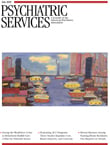Letter
Documentation of Suicide Risk Assessment in Clinical Records
To the Editor: Adequate assessment of individuals who attempt suicide can reduce further attempts ( 1 ) and help to determine the most appropriate treatment. Most guidelines for management of self-harming patients recommend direct discharge from the emergency department only after a psychosocial assessment has been conducted and an aftercare plan has been arranged ( 2 ). However, these recommendations are not always followed ( 3 , 4 ). Given clinicians' apparent lack of adherence to these guidelines and limited knowledge about their actual practice ( 5 ), we analyzed the quality of clinical records of patients seen in four public university hospitals in Madrid after a suicide attempt.
We selected seven indicators that would provide the minimum information needed to evaluate a patient's risk of a subsequent suicide attempt: previous psychiatric treatment, suicidal ideation, suicide planning, medical lethality of the suicide attempt, previous attempts, attitude toward the current attempt, and social or family support. We investigated the presence of these indicators in 993 clinical records of 907 patients (600 women, 66%) between the ages of six and 92 (mean±SD= 37.2±15.3 years). These patients were seen from November 9, 2007, to March 8, 2008, in the emergency room after a suicide attempt in the community or in the hospital after an attempt in the inpatient setting. Institutional review board approval was obtained from the ethics committee of each hospital.
A total of 223 records (23%) documented all seven indicators, and 306 (31%) included documentation for six. Using the criterion that at least five indicators should be included, we found that 235 records (24%) could be considered incomplete. If a more restrictive criterion were used (a minimum of six indicators), only 529 assessments (53%) could be considered adequate. The indicators most often missing were previous suicide attempts and medical lethality of the current attempt.
A score was created by adding the number of indicators present in the record (0, not present, 1, present). We found no significant differences in the total score between men (5.26±1.60) and women (5.30±1.53). Patients hospitalized (in psychiatric or medical units) had significantly more complete records (5.50±1.55) than those discharged from the emergency department (5.29±1.47) (z=2.73, p=.006), which might reflect a longer period during which to evaluate hospitalized patients.
Information about previous suicide attempts was missing from 435 records (44%). For the 139 known first-time attempters (25% of the 558 records that included information about previous attempts), the total possible score was 6 (excluding the indicator for previous attempts). Records for first-time attempters were more complete (5.27±.95) than records for those who had made previous attempts (4.93±1.12) (z=3.51, p<.001), which may indicate that physicians recorded fewer details for patients who were already known to them.
Even though patients in this sample were seen at four university hospitals with 24-hour emergency services for persons with general medical or psychiatric problems, many of the clinical records of those who had attempted suicide were incomplete. Better documentation of the risk of a subsequent suicide attempt could improve decision making regarding treatment and referral ( 1 ) as well as improve evaluation and follow-up of the same individuals if they visit the hospital after a future attempt, whether or not they are seen by the same physician. Accurate documentation of suicide attempts could also benefit suicide prevention campaigns targeted to at-risk populations.
We suggest the use of semistructured screening instruments to improve assessment of these patients, which would ensure implementation of clinical guidelines.
Acknowledgments and disclosures
The study was funded by the Instituto Madrileño de Salud Pública and supported by CIBERSAM, Instituto de Salud Carlos III.
The authors report no competing interests.
1. Kapur N, House A, Dodgson K, et al: Effect of general hospital management on repeat episodes of deliberate self poisoning: cohort study. BMJ 325:866–867, 2002Google Scholar
2. Baca-Garcia E, Perez-Rodriguez MM, Basurte-Villamor I, et al: Using data mining to explore complex clinical decisions: a study of hospitalization after a suicide attempt. Journal of Clinical Psychiatry 67:1124–1132, 2006Google Scholar
3. Baraff LJ, Janowicz N, Asarnow JR: Survey of California emergency departments about practices for management of suicidal patients and resources available for their care. Annals of Emergency Medicine 48: 452–458, 2006Google Scholar
4. Barr W, Leitner M, Thomas J: Psychosocial assessment of patients who attend an accident and emergency department with self-harm. Journal of Psychiatric and Mental Health Nursing 12:130–138, 2005Google Scholar
5. Baca-Garcia E, Diaz-Sastre C, Resa EG, et al: Variables associated with hospitalization decisions by emergency psychiatrists after a patient's suicide attempt. Psychiatric Services 55:792–797, 2004Google Scholar



